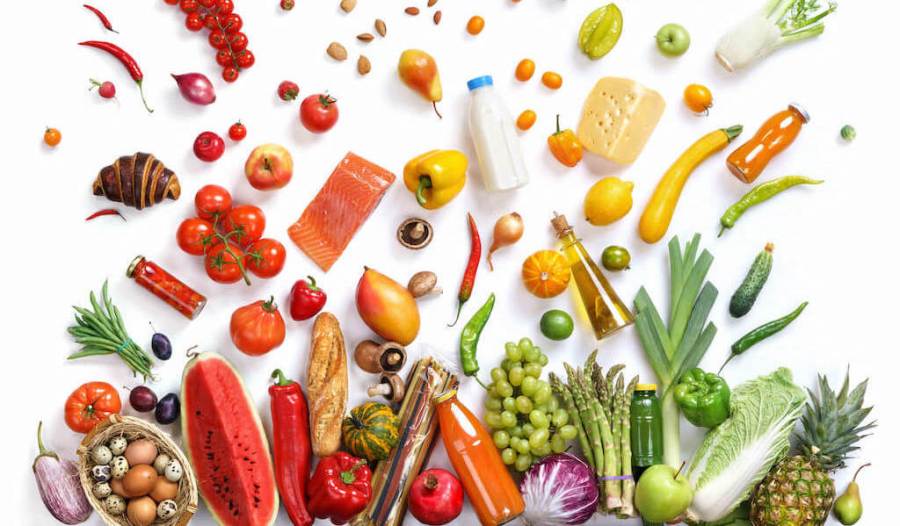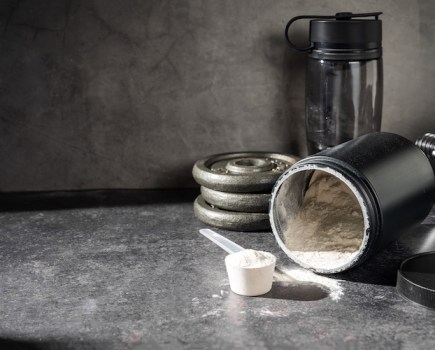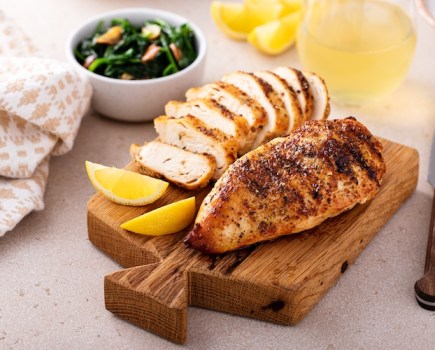Regular exercise and training with sufficient intensity is all well and good, but if your nutrition isn’t up to scratch, you won’t be getting the most bang for your buck from those workouts you’ve been slaving over.
You know about protein, the importance of fruit and veg, and why too many post-work pints aren’t doing you any favours in the quest to shift belly fat, but there are some other crucial tweaks you could be making.
You’re busy, we get it. And sometimes the food you eat day-to-day is the last thing on your mind.
So we’ve rounded up some simple, expert-approved and scientifically backed nutritional tips to nudge you a little further in the right direction…

The capsaicin in chilli peppers could help with feelings of fullness | Photography: Shutterstock
How to eat for fat loss
01. Chew your food
Chew, chew and chew again. Studies have found that chewing your food properly decreases your hunger as well as your food intake. Try 20 chews per bite.
02. Don’t empty the tank
While calories in versus calories out is the fundamental equation for fat loss, it’s also important to consider what else you’re doing.
If you’re training hard, you need to adjust accordingly. Plan your meals in line with your exercise and work schedules, and take into account carbohydrate and energy requirements for each.
If you’re exercising less, you may need to decrease the amount of carbs you’re consuming (if fat loss is the aim). But carbs are not the enemy, and if you start exercising more frequently again you should gradually increase your intake.
03. Fill up with ‘volume foods’
“Volume foods, such as spinach, lettuce, cucumber, gherkins and cabbage, can bulk out a meal for increased satiety without masses of calories,” says Liam Holmes, nutritionist and Foodspring ambassador.
04. … Sniff an orange?
Far from a long-term solution, but if you find yourself reaching for dessert number two, research suggests the smell of citrus fruit can act as a deterrent – making sweet treats less appealing.
05. Pick your plates
When participants in one study ate their meals off white plates, rather than black or red, their food intake was reduced.
06. Spice things up
We’re not suggesting you blow your head off with Carolina reapers, but research in 2014 found that the capsaicin in chilli peppers could help with feelings of fullness, avoiding the need to reach for more food after mealtimes.
07. Avoid liquid calories
You might not think much of that Starbucks Venti Caffe Latte with Oat Milk (261 calories), the five pints of beer on a Friday night (208 calories per pint), or free-pouring cooking oil into the pan (120 calories per tbsp).
But liquid calories do count, and unless you track them and factor them into your calorie deficit – which, lest we forget, is the only thing that’s going to reduce body fat – they may be tipping you over the mark.
08. Cut calories sensibly
Dropping down to 500kcals a day won’t be something you can sustain for long.
“Reduce calories by about 10 to 20%,” says specialist dietitian Nichola Ludlam-Raine. “If you’d usually consume 2,500 calories a day, start with a reduction of 250.”
Cut calories too drastically and you’ll lack the energy to exercise. Not only that, your body may also start to lower its metabolic rate in order to conserve energy – making it harder to shift any unwanted flab.
09. Go go glucomannan
Proven to help with satiety, glucomannan is a water-soluble, natural fibre. In one study, when taken daily over eight weeks, it led to a mean weight loss of 5.5lbs – even when diet and exercise were unchanged.
Available as a pill or powder, glucomannan turns water into gel to keep you fuller for longer.
10. Beans are best
Talking of fibre, enjoying more beans and legumes – fibre-filled plant foods – has been shown to help reduce belly fat.
The Journal of Nutrition and Metabolism explained how a low glycemic index and high fibre count contributes to beans being a useful tool in weight management, with higher intakes being associated with ‘less abdominal obesity’.
11. Eat for sleep
A decent night’s shut-eye plays a big part in weight loss, and the right foods can help you get it. In particular, tryptophan-rich foods are key.
“Your brain needs tryptophan in order to make the sleep hormone melatonin,” says nutritionist & gut health specialist Marilia Chamon. “Good sources include fish, eggs, rice, oats, chickpeas, soybeans, tofu, chia, sesame and pumpkin seeds.”
12. Stay hydrated
Increased hydration can lead to weight loss, says a review published in Frontiers in Nutrition. Plus, dehydration is one of the quickest routes to fatigue and a bad mood.
Water is key, but so are electrolytes, says Chamon: “Those electrolytes include sodium, potassium, calcium and magnesium, found in fresh whole foods. We also need essential fatty acids omega-3 and omega-6, found in nuts and seeds, to hold water in the body.”
“Soups and broths can increase your fluid intake,” adds Rob Hobson, head of nutrition at Healthspan Elite, “and make healthy meals or even snacks between meals. Watery fruits, such as melons and oranges, also hydrate and provide a source of energy when training.”
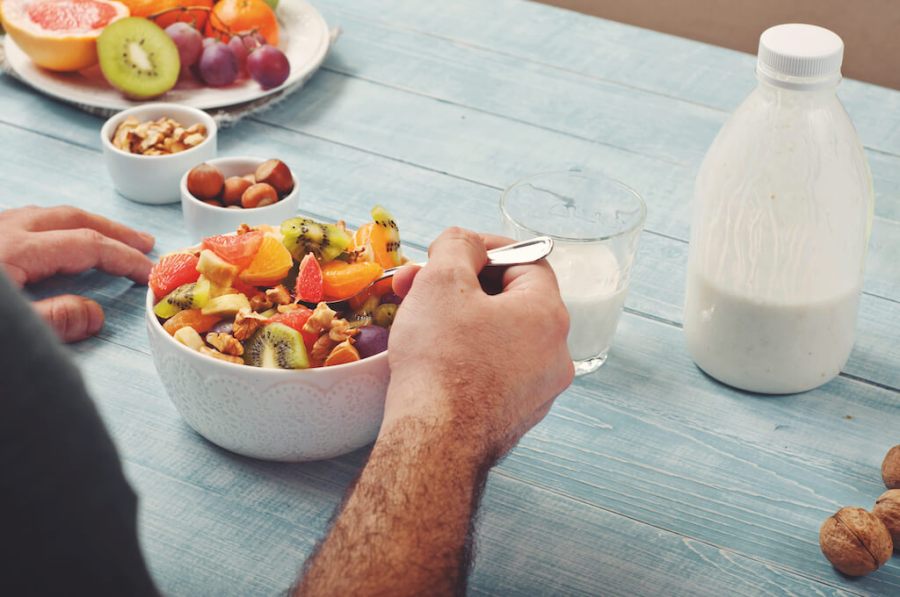
Only 30% of men hit the recommended fibre intake
How to eat for better general health and wellbeing
13. Manage meat intake
“Go meat-free at least once a week,” advises Hobson. This is not only good for your health, but has you doing your bit for the environment.
“Swap chicken for Quorn or marinated tofu in a stir-fry,” he adds, “and swap mince in a bolognese sauce or chilli for Quorn mince or canned beans.”
14. Hit the magic number
“When it comes to hitting your five-a-day fruit and veg quota, one portion equals 80g,” says Ludlam-Raine.
“This should come from different coloured fruit and vegetables, as each different food has a unique set of nutrients.”
15. Fill up with fibre
Only 13% of men meet the recommended 30g a day.
“Fibre helps reduce the risk of heart disease, high cholesterol, type 2 diabetes and colorectal cancer, while also helping you to maintain body weight,” says Hobson. He adds: “Eat more vegetables, switch to brown, wholegrain carbs and eat more legumes.”
16. Fish for your supper
To keep your ticker healthy, tuck into at least two portions of oily fish a week.
Think mackerel, sardines and salmon, which studies – published in the journal Frontiers of Nutrition – have shown could also prevent or slow down the development of brain disorders, such as Parkinson’s. All thanks to oily fish’s anti-inflammatory nutritional make-up.
17. Add more veg
Yeah, yeah, yeah, the usual. But this is the simplest way to improve your overall health and reduce your risk of disease.
“Always think, add one more,” says Hobson. “Keep ‘easy’ veg, such as frozen peas and soya beans, to hand, which can be added to any hot meal.
“Spinach is the same, and green beans or tenderstem broccoli are also hassle-free and quick to prepare.”
18. Be balanced
Eating a balanced diet will ensure you get the nutrients your body needs to support your immune system, but it’s also advisable to supplement with vitamin D during the winter months.
“Probiotics may be useful for immune health during periods of intense training,” Hobson adds. “And if you’re travelling overseas to compete, try starting a course or probiotics a couple of weeks beforehand.”
19. Check for accreditation
Food should always come first, but including a multivitamin and mineral supplement is a cheap way to ensure you’re getting everything you need.
“Look for a supplement that is Informed Sport approved,” advises Hobson. Try Healthspan Elite Gold A-Z Multivitamin (£11.99 for 120 tablets).
20. Be wary of sports drinks
“They’re basically full of sugar,” says Hobson, “and only of benefit to those training aerobically or competing in races lasting more than an hour. When you’re training in the gym, you need nothing more than water.”
21. Stay active
Frequent ejaculation is linked to a decreased risk of prostate cancer. But if your libido isn’t firing up like it used to, it could be a sign of a hormonal imbalance, such as testosterone deficiency, says Chamon:
“Within body fat, there is an enzyme called aromatase. This regulates the conversion of testosterone to the female hormone estradiol. If you have low testosterone, which can lead to a low libido, then you’ll want to lower this conversion.”
Enjoy flaxseeds, organic non-GMO soy, white button mushrooms and green tea to slow down aromatase activity.
22. Face fats
Omega-3s are healthy fats worth knowing about. These essential fatty acids reduce inflammation and blood triglycerides, both of which are associated with heart disease.
Oily fish (salmon, trout, mackerel) are the best sources. Nuts and seeds offer some omega-3, too, but this type is poorly converted in the body.
23. Zinc smart
It’s needed for a healthy immune system, wound healing, and sexual health and fertility.
“Foods high in zinc include beef, shellfish, pumpkin seeds and lentils, with oysters topping the list,” says Mike Murphy, chief nutritionist for Vitaminology. If you’re a vegan or you drink alcohol regularly, consider supplementing 15-30mg of zinc per day, but balance it out with 1-2mg copper.
“Zinc is a key nutrient for men,” adds Hobson, “as it helps to promote good reproductive and prostate health. Include foods like wholegrains, edamame beans, lentils, nuts, seeds, seafood, low-fat yogurt and mushrooms in your diet. Try making a three-egg omelette with mushrooms and pumpkin seeds.”
24. Diversify your microbiome
Healthy gut bacteria helps to reduce the chances of chronic diseases, including cancer, inflammatory bowel disease and obesity.
Chamon says it’s been proven that eating 30 different plant foods per week leads to a more diverse gut bacteria composition than eating ten or fewer plants per week.
Sound daunting? “Different varieties of the same foods count towards that, for example different varieties of apples, pears, tomatoes and potatoes,” she adds.
25. Up the anti
Dubbed the master antioxidant, glutathione helps to overcome oxidative stress in the body.
“Boost your glutathione by eating vegetables such as broccoli, cauliflower, cabbage, Brussel’s sprouts and kale, as well as sulphur-rich vegetables such as garlic, onion and shallots,” says Chamon.
“These all help with glutathione production. Polyphenol epigallocatechin gallate (EGCG), found in green tea, has also been shown to promote glutathione.”

Portion out your protein intake throughout the day for optimal muscle growth
How to eat for muscle and strength
26. Look for leucine
“This amino acid stimulates muscle protein synthesis, which helps to initiate regenerating and building muscle mass,” says Ludlam-Reine.
Leucine is mostly found in animal proteins: eggs, milk, whey powder, meat and fish.
Plant-based? “Opt for complete sources of protein, such as soya, vegan protein powders (which contain all the essential amino acids) and mycoprotein.”
27. Recover right
Post-exercise nutrition is just as important as fuelling your body pre-exercise.
Protein is vital for effective recovery, and the anabolic effect of consuming protein post-exercise is long-lasting. Think about eating meat, fish or even plant-based foods to aid with muscle recovery and development.
Oily fish, such as wild salmon, is high in omega-3 and can also support with inflammation management.
28. More meals = more muscle
“Increase meal frequency rather than meal size,” says Liam Holmes. “That makes it easier to consume enough calories – and protein – to pack on muscle.”
Speaking of which…
29. Portion out protein
Nichola Ludlam-Raine says that it’s not just about ensuring you’re eating enough protein – the timing and the quality matters, too.
“Aim for 0.3g to 0.4g of protein per kg of bodyweight after strength and resistance training, to support muscle protein synthesis,” she says.
And distribute that protein evenly throughout the day for better absorption. If you’re aiming for 1.6g per kg of bodyweight, eat 25-30g at each meal – and make up the rest in snacks.
30. Drink beets
A study published in the journal Nutrients found that when 70ml of beetroot juice was taken two hours before training, the
total rep count of back squats and bench press increased.
31. Shake it off
“A shake containing 25-30g of protein is ideal after a weights session. Any more won’t be used by the body,” says Hobson.
32. Snack right
An easy high-protein snack, beef jerky also packs in B vitamins and iron.
Enjoy as an alternative to shakes and powders post-workout. Just look for the low-salt variety.
33. Power up plants
Vegan or trying to cut down on animal products?
“If your plant-based shake contains less than 20g of protein,” says Hobson, “pair it with a small amount of carbs, as that will help with the protein uptake.”
34. Veg out
“Polyphenols – the colourful chemicals found in plants – work to reduce inflammation, as well as improving the ability of the gut microbiome to produce helpful postbiotics, which play a role in better overall body composition,” says Dr Federica Amati (PhD), nutritionist and chief nutrition scientist for Indi Supplements.
Berries, beetroot, aubergine, red peppers and broccoli play just as big a role in muscle composition and strength as protein does.
35. Keep up the creatine
“A substance found naturally in muscle cells, creatine helps to produce energy during heavy lifting sessions, which means more power to push harder,” says Hobson.
“Take 20g per day in four equal doses, for seven days, then drop to 5g per day.” Long-term use of up to four years, he adds, has been shown to be safe.
36. Sleep on it
A study published in Frontiers in Nutrition found that 40g of casein, taken after an evening resistance-based workout and 30 minutes before sleep, could help with muscle recovery and increase protein synthesis.

Make your mid-workout drink carb-based and simple
How to eat for endurance sport
37. Shell out
Long workouts can wreak havoc with joints. Glucosamine, available in supplements, can help with stiff joints. It’s also found in the shells of shrimp, lobster and crab.
38. Wait for nitrates
Proven to improve performance in endurance sports, Holmes recommends nitrate-rich foods, such as beetroot, rhubarb, carrots, and green veg.
39. B better
A busy training schedule, alongside a hectic work life and stress, can deplete the body of nutrients. They includes B vitamins, which support a healthy nervous system and help to break down food into energy for the body.
Seafood, quality meat, leafy green veg and fortified cereals are all good sources of B vits.
40. Call for carbs
Make your mid-workout drink carb-based and simple. “Perfect for those longer sessions, carb powders, fruit juice or coconut water are good options,” says Holmes.
41. Manage your minerals
Sweating is your body’s defence system against overheating. Unfortunately, though, when you sweat, you also lose some important minerals known as electrolytes, including sodium and potassium.
As mentioned previously, electrolytes support a number of bodily functions, including energy production and fluid balance.
“It is very important to replace the electrolytes lost when you sweat,” explains sports nutritionist Will Girling. “At best, you will see an unwelcome decline in your performance. At worst, you can get hyponatremia (low blood sodium), which can be deadly.
So, during extended exercise, take on an electrolyte source once an hour. Around 400mg of sodium – or one electrolyte tablet – should cover most people.”
42. Pump iron
“Iron is an essential nutrient for endurance performance that is often overlooked,” says Holmes. “Good sources include high-quality red meat, beans, seeds, dried fruit and leafy green vegetables.”
43. Be a GI Joe
“If you’re training for any longer than 60 minutes, you may benefit from including a high-GI source of carbohydrates for an immediate top-up of energy,” says Ludlam-Reine. Try a handful of Jelly Babies or Haribo.
44. Hit the scales
“Training for one hour a day means eating 5-7g of carbs per kg of bodyweight,” says Hobson.
“Training one to three hours a day requires 6-10g per kg of bodyweight. But if you’re not used to eating high amounts of carbs, build up slowly to avoid any gut discomfort.”
No scales? Simply aim to fill a third of your plate with starchy carbohydrates.
45. Avoid pre-race fibre
It’s wise to carb-load 48 hours before any event lasting more than 90 minutes. “Aim for 10-12g per kg of bodyweight,” says Hobson, “which will mean reducing your protein intake.
“Choose low-fibre carbohydrates to avoid any bloating or gut discomfort. Make sure you test this out before a long training session to establish your tolerance to carbohydrates, and on race day aim for 1-4g carbs per kg of bodyweight, four hours beforehand.”
46. Get the shots in
Caffeine has been proven to help with endurance exercise. If you’re tolerant to it, aim for 5-6mg of caffeine per kilo of bodyweight before you set off – this is the amount proven to be effective in improving exercise performance.
For comparison, a mug of filter coffee contains around 140mg of caffeine.
47. Savour sodium
Avoid muscle cramps by enjoying salty carbs pre-workout. Salted nuts, processed bread and some cereals are all good options.

The phytonutrients in dark chocolate support brain health
Best foods for better mental health
48. Hit the bar
“Phytonutrients, such as cocoa flavonoids, support the brain,” says Nigel Mitchell, performance nutritionist and expert for Healthspan Elite. Stick to dark chocolate, though – the darker the better.
49. Take your meds
“There’s research that shows an association between effects following a Mediterranean-style diet and a reduction of symptoms associated with anxiety and depression,” says Ludlam-Raine. Fill up on mostly plant-based foods, such as fruit and veg, wholegrains and healthy fats.
50. Ban booze in the week
Alcohol is full of ‘empty’ calories. Pippa Campbell, nutritionist and ‘nutrigenomics’ practitioner, recommends a Monday to Friday ‘no alcohol’ rule.
“Try a Kombucha instead,” she says, “which also has the benefits of feeding your good gut bacteria. A happy gut also equals a happy mind, as serotonin (the happy hormone) mostly resides in the gut and makes us more resilient to stress.”
51. Make room for magnesium
There’s stacks of research associating very low magnesium intake with depression.
To help avoid this deficiency, Hobson advises loading up your plate with magnesium-rich foods, such as dark-green leafy vegetables, beans, pulses, wholegrains, nuts and seeds.
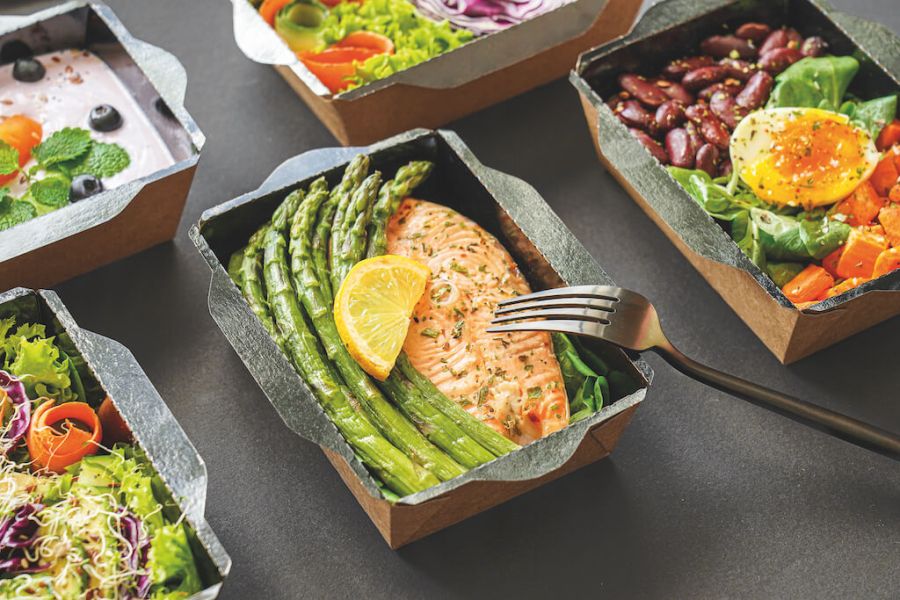
Simple but effective: batch cook your weeknight meals ahead of time
Quick tips to save time in the kitchen
52. Have a grain wave
“Make use of ready-cooked grains to save time in the kitchen,” says Hobson. “These pouches include rice, lentils and quinoa. Chuck them in a pan with some chopped veg and protein of your choice, then add pesto or soy for a quick-fix nutritious meal.
Try egg-fried rice: fry chopped red pepper and onion in sesame oil, then add your rice pouch. Add a beaten egg and fry for a while until cooked, then add frozen peas or canned sweetcorn, coriander and soy sauce.”
53. Batch cook
When you get your mojo in the kitchen, try to cook twice the quantity.
“One-pot dishes can be frozen, but other meals can be stored in the fridge for quite a few days,” says Hobson. “Aside from lunch and dinner, you can serve smaller portions of leftovers as snacks – useful if you’re trying to gain weight.”
54. Plan ahead
Easier said than done, but if you have healthy food in stock and you know what you’re eating across the week, it can take some of the hassle out of cooking.
Deciding what to cook after work is all part of the problem.
55. Get ready
Having something to hand that you can chuck in the oven is a major time-saver. Stock up on healthy ready meals, such as marinated meats, fish or plant-based alternatives.
These can also be cooked from frozen, so stick a few in the freezer. “Serve them with ready-cooked grain pouches and salad for a hassle-free meal,” says Hobson.

